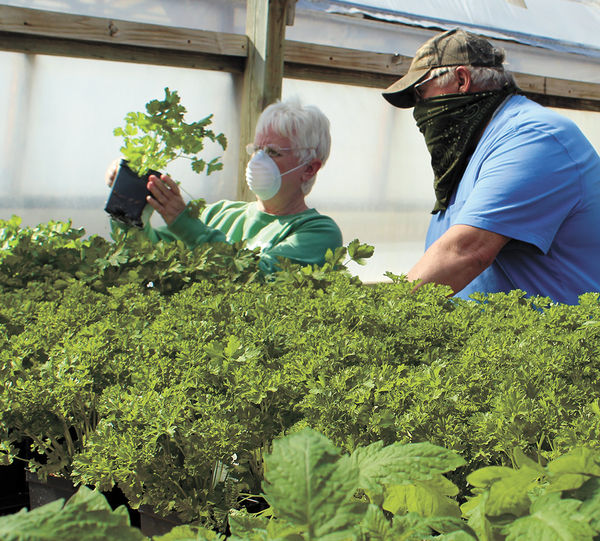Iowans increase gardening during crisis -like they did in the past Iowa author says

Customers select garden plants at Norton’s Greenhouse in Toledo on Thursday afternoon, April 30, as the spring planting season gets into full swing. Outdoor gardening has seen a rise in activity this year attributed to COVID-19 circumstances by Iowa City garden history author Beth Cody. Chronicle/John Speer
IOWA CITY (The LINK) – In these uncertain days of social distancing and staying at home, Iowans are turning to their gardens in record numbers. Whether planting productive gardens for food security or planting flowers for beauty and solace (usually both), the numbers are up: home improvement centers across the nation and in Iowa have seen a jump in garden product sales this spring, and local Master Gardener hotlines are fielding an increase in gardening questions.
In a time of health and food worries, many Iowans instinctively understand that growing food is a good idea, spending time outside in the sunshine is healthy, and seeing the miracle of seeds becoming plants and the beauty of flowers helps us mentally.
But gardening enthusiasm isn’t unusual for Iowans, who’ve had a close bond with the soil since the establishment of our state, according to rural Johnson County resident and gardening enthusiast Beth Cody. She’s the author of a new book about the history of Iowa gardening, Iowa Gardens of the Past: Lost and Historic Gardens of Iowa, 1850-1980.
Cody asserts, “Iowans have long been avid gardeners – and even influential garden writers and horticultural entrepreneurs. Today’s Iowans are simply returning to their roots.”
Iowans have loved gardening for many generations
Nineteenth-century Iowans indulged in the Victorian fashion for ornamenting their yards, first with trees and shrubs, and later with newly-discovered tropical flowers – in addition to orchards and large vegetable gardens to feed themselves.
By the 1920s, Iowa seed company entrepreneurs like Earl May and Henry Field influenced how people across the nation gardened through the millions of catalogs they sent to customers, and their radio stations that broadcast to thousands of listeners.
During World War II, Iowans outdid themselves in Victory Gardening: an incredible 70% of Iowa households grew Victory Gardens – more than 475,000 gardens totaling 90,000 acres, a fifth of an acre in average size.
After the war, Iowa’s garden clubs peaked in membership, with more than 200 clubs across the state by 1960.
Growing environmental awareness in the 1970s led to a return to Grandmother’s Garden: vegetable gardening, as well as interest in daylilies and other flowers that grow easily in Iowa gardens, requiring fewer pesticides.
Iowa’s Master Gardener volunteer program, established in 1979, has one of the highest rates of participation in the nation, according to Cody’s research. Iowans love gardening, as well as helping others learn how to garden.
Researching Iowa Gardens
Cody should know about Iowa’s long love affair with gardening: she spent five years researching the subject and looking for vintage photos of Iowa gardens in libraries and archives across the state, in online collections and on Ebay.
She found illustrations of Iowa gardens from as early as the 1860s; Victorian-era garden photos; turn-of-the-century postcard images; magazine photos of gardens from the “Roaring Twenties” through the mid-century modern period; and nostalgic Iowa seed catalog art from the 1870s to the 1970s.
Iowa’s gardens have ranged from grand estates in Burlington, Keokuk and Cedar Rapids; to beautiful suburban gardens in Des Moines and Iowa City; to lovely flower-filled farmsteads in rural areas in every corner of Iowa.
A Reassuring Link With The Past
The recent increase in gardening is just another chapter in Iowa’s long history of garden interest, says Cody. And during our current troubles, seeing how Iowans gardened in the past provides a reassuring perspective.
“There’s something comforting during these uncertain times in seeing the vintage garden pictures that I’ve included in my book. Our great-grandparents had to deal with world wars, epidemics and economic depressions – they knew real hardship. And that they were able to make such beautiful gardens despite these disasters – and also in the face of grasshopper plagues, droughts and some of the worst winters ever recorded – it’s truly inspiring.
“It’s ultimately reassuring, because it shows us that Iowans persevere. We get through these hard times, we feed ourselves and the rest of the world, and we still manage to create beauty around us.”
Published this week, Cody’s book is filled with hundreds of vintage images of Iowa gardens and seed catalog art, and is available for sale at Iowagardens.com – just in time for Mother’s Day.




